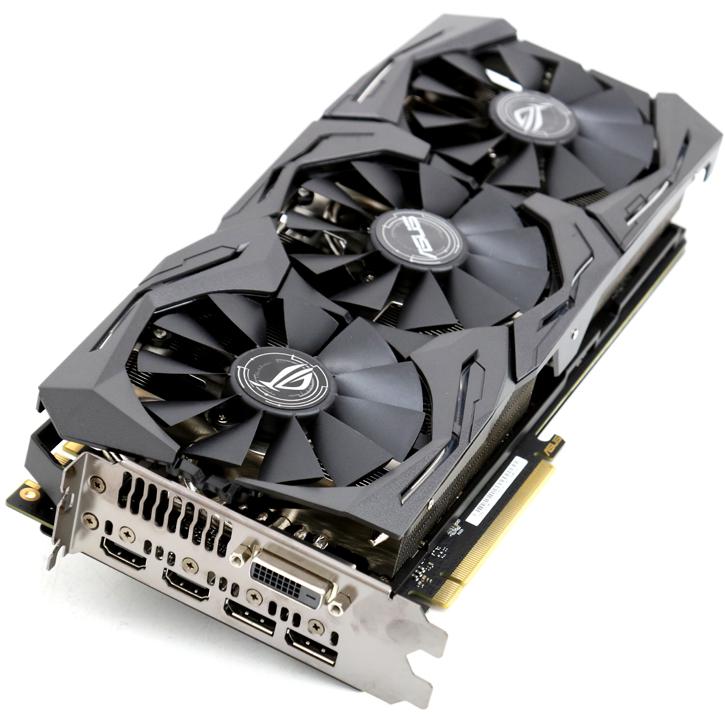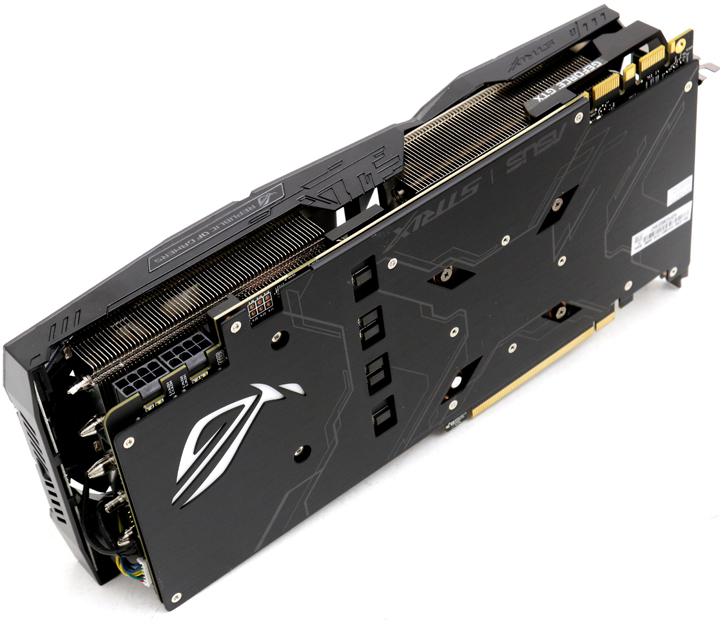Conclusion
Conclusion
There is no doubt that the new STRIX is VERY fast, depending on how GPU bound you are you will be looking at a product that is a good 5% faster compared to the reference Founders Edition card. Very nice to see is the new cooling solution. ASUS stepped away from their DirectCU cooling design and sure the new one seems to behave well. The GP102 GPU is a beast in terms of heat any cooler needs to draw away. Looking at the results the ~67 Degrees C is the baseline, and that is good. The looks and design as well are pretty terrific, albeit I am not a fan of big LED activated logos, and ASUS is doing that on the back-plate with the ROG logo. Now I stated this in my other reviews already, unless any of the AIB GTX 1080 Ti cards will be bursting into flames or something, we will be recommending them. Like the price or not, the GeForce 1080 Ti series delivers an insane amount of RAW game performance. The MSRP of 699 USD is for the the Founders Edition. ASUS however is offering a premium product, and as such it will be priced like that as we spotted this SKU at € 829,- with a similar price USD wise. That is an incredible amount of money to play games, but yeah once you have one of these puppies in your PC, you'll forget about that pain you had to cough up instantly - as this product series simply delivers. In the Founders Edition review I stated that the cooler is not enough for the beast inside. It throttles (albeit within advertised specifications) and is a bit on the noisy side.So the board partner SKUs are all clocked faster compared to the reference (founders edition) products. Overall you are looking at another 5% to 7% on average extra in performance and another 5% by tweaking it yourself. And that means the product as tested today passes Titan X performance levels. So in retrospect the GeForce GTX 1080 Ti simply is a beast and probably the ultimate card series to get for an enthusiast class gaming PC.
Aesthetics
The STRIX is a very nice looking card. There's little more to say really. I like the dark design and sure, the LEDs. All the extra RGB LED functionality like an RGB LED strip connector for me is not needed, hey haters will hate lovers will love it. Switch it on/off or to any color and animation you prefer, the choice is yours. Cool dibs is that backplate, with opening at the proper areas (GPU/VRM) for venting. As you can see, I remain skeptical about backplates, they potentially can trap heat and thus warm up the PCB. But the flip-side is that they do look better and can protect your PCB and components from damage adn well, it can look nice so it has an aesthetic appeal as well. Consumer demand is always decisive, and you guys clearly like graphics cards with backplates. Both the front IO plate and backplate are dark matte black which certainly gives the card that premium feel. All that combined with a nicely design 10+2 phase PCB again in matte black, and the end result is a lovely STRIX, and this lovely looking product.
Cooling & Noise Levels
The reference design (founder editions) of the GTX 1080 Ti are set at an offset threshold of 80 degrees C and easily hit 84 Degrees C under load/stress. As such the reference cards, once the GPU gets warmer, will clock down on voltage and base turbo clock to try and keep the card at that temperature threshold. That throttling and it part of the design. This is not a problem for the ASUS STRIX card, as they throw heaps of cooling performance onto the GPU, memory and VRM area. History has proven that this concept works and is a really good one, so good that up-to a degree or 55~60 on the GPU this flagship card remains passive and thus inaudible. Once the fans kick in, you can expect to hover at the ~67 Degrees C marker, with seriously demanding games. Please do note that you will need proper ventilation inside your chassis to achieve that number as the card oozes out quite some heat at the top side of the VRM area. Overall though the enw cooling design shaves off over 10 Degrees C over reference. Noise wise, we can’t complain about cooling whatsoever. Expect (silent) sound pressure values in the ~39 dBA range at max under load and warm circumstances. That's measured 75 CM away from the PC. This means you can barely hear the card while using it. Once overclocked you could add voltage and here we always do recommend a little more fan RPM, this does increase noise a tiny bit, but it's nothing dramatic by any standard. Overall this is a very silent and solid cooling solution. The card does produce a tiny bit of coil noise, nothing annoying but there is some that can be heard in high-fps situations. We doubt very much you could even notice it in a closed chassis.
Power Consumption
The GP102-350-A1 Pascal GPU is rated as having a 250 Watt TDP, our measurements show numbers slightly above that being closer to 300 Watts. This STRIX sits at roughly 285 Watts. Keep in mind that this is a peak maximum value under full stress. At this performance level you are looking at 500 Watts for the PC in total, that is okay. We think a 600~650 Watt PSU would be sufficient and, if you go with 2-way SLI, an 800~900 Watt power supply is recommended. Remember, when purchasing a PSU aim to double up in Wattage as your PSU is most efficient when it is under 50% load. Here again keep in mind we measure peak power consumption, the average power consumption is a good notch lower depending on GPU utilization. Also, if you plan to overclock the CPU/memory and/or GPU with added voltage, please do purchase a power supply with enough reserve. People often underestimate it, but if you tweak all three aforementioned variables, you can easily add 200 Watts to your peak power consumption budget.
Gaming Performance
From 1080P to Ultra HD the GeForce GTX 1080 Ti shows some serious numbers. But here's a paradox - the more difficult things get - the better the product will perform. E.g. Ultra HD is its true domain. Much like fine wine that ages well, that means this GeForce GTX 1080 Ti will last you a long time with future more GPU intensive games. This much performance and 11 GB of GDDR5X graphics memory helps you out in Ultra HD, DSR, VR and hefty complex anti-aliasing modes. That and of course the latest gaming titles. I consider this to be a very viable single GPU solution that allows you to game properly in Ultra HD with some very nice eye candy enabled with a single GPU. Drivers wise we can't complain at all, we did not stumble into any issues. Performance wise, really there's not one game that won't run seriously well at the very best image quality settings. Gaming you must do with a nice Ultra HD monitor of course, or at least a 2560x1440 screen. Now, we can discuss the advantages of that 11 GB frame-buffer, but hey, you can draw your own conclusions there as performance isn' t limited. And with 11 GB of it, you won't run out of graphics memory for the years to come, right? So in that respect the card is rather future proof.
Overclocking
The boost modes can be configured with temperature targets relative to maximum power draw and your GPU Core frequency offsets. Saying that I realize it sounds complicated, but you'll have your things balanced out quite fast as these products are easy to tweak. This GPU can take a rather hefty Boost clock, once tweaked (start with +50 MHz on the GPU and a maxed out power limiter) and you'll see your games rendering in the 1950~2000 MHz domain. The memory you'll be able to get close to roughly ~12 GHz for an effective data-rate. For a GPU with 12 Billion transistors, you've gotta be at least a tiny bit impressed, right? With our tweak we averaged out at a ~2 GHz boost frequency.
Concluding
ASUS really has got a new card at hand, not just because of the obvious, the GP102 GPU but the overall aesthetic feel and feature-set has improved. You'll get a spot on designed PCB with 10+2 power phases and proper component selection. The icing on top of the cake however is the new cooler design. ASUS has been fighting MSI with their excellent TwiNFrozr concept in the heat and noise level segment. That factor has now been equalized as we see close to similar performance for both cards. That means the STRIX is silent and cool. Your stress gaming temperature will sit at just under a 70 Degrees C threshold, which is pretty good considering what GPU lies under the hood. In my previous 1080 Ti review I have not recommended cards like these for 1080p gaming. I am revising that claim a bit as there are people that want 144 FPS on their 144 Hz monitor of course. Next to that 1080p rendering with DSR enabled also can have it's benefits, and this card would be perfect for that. Broadly speaking though, at 2560x1440 the card really kicks in and at this resolution the 1080 Ti actually makes a lot of sense as it has heaps of power and memory hence. It is going to last you a long time. Really, the GeForce GTX 1080 Ti is that Wolf Titan X in disguise. Nvidia had to do something to it and decided to ditch 1GB of memory, bringing that VRAM number to a weird 11GB. This means slightly fewer ROPs and a rather unusual 352-bit memory bus as well. But then they do use faster DDR5X memory and slightly faster than Titan X clock frequencies. So the performance drop is immediately annihilated and in fact the GeForce GTX 1080 Ti is as fast or sometimes even faster compared to the Titan X (Pascal). You've seen the numbers, for Ultra HD gamers and even 2560x1440 gamers this product works out well, really well. Overall we are impressed by the GeForce GTX 1080 Ti, very much so. Compared to the founders edition from Nvidia this product has improved on performance with roughly a 5% to 7% average, it has low noise levels and nice cooling levels. A handy side-effect here is that the card will not throttle down. The price is obviously the biggest conundrum with the custom premium editions 1080 Ti card, this puppy sits at that harsh € 829,- / USD domain. It is the one thing that remains to be an icky thing, but as always this is Nvidia's fastest consumer based GPU for the masses, and it comes at a price premium. The truth remains that if you can afford it, we can definitely recommend it. The ASUS STRIX GeForce GTX 1080 OC edition here also is ticking all the right boxes. A GeForce 1080 Ti done right.
We like it very much.
- H
Recommended Downloads
- Sign up to receive a notice when we publish a new article
- Or go back to Guru3D's front page



